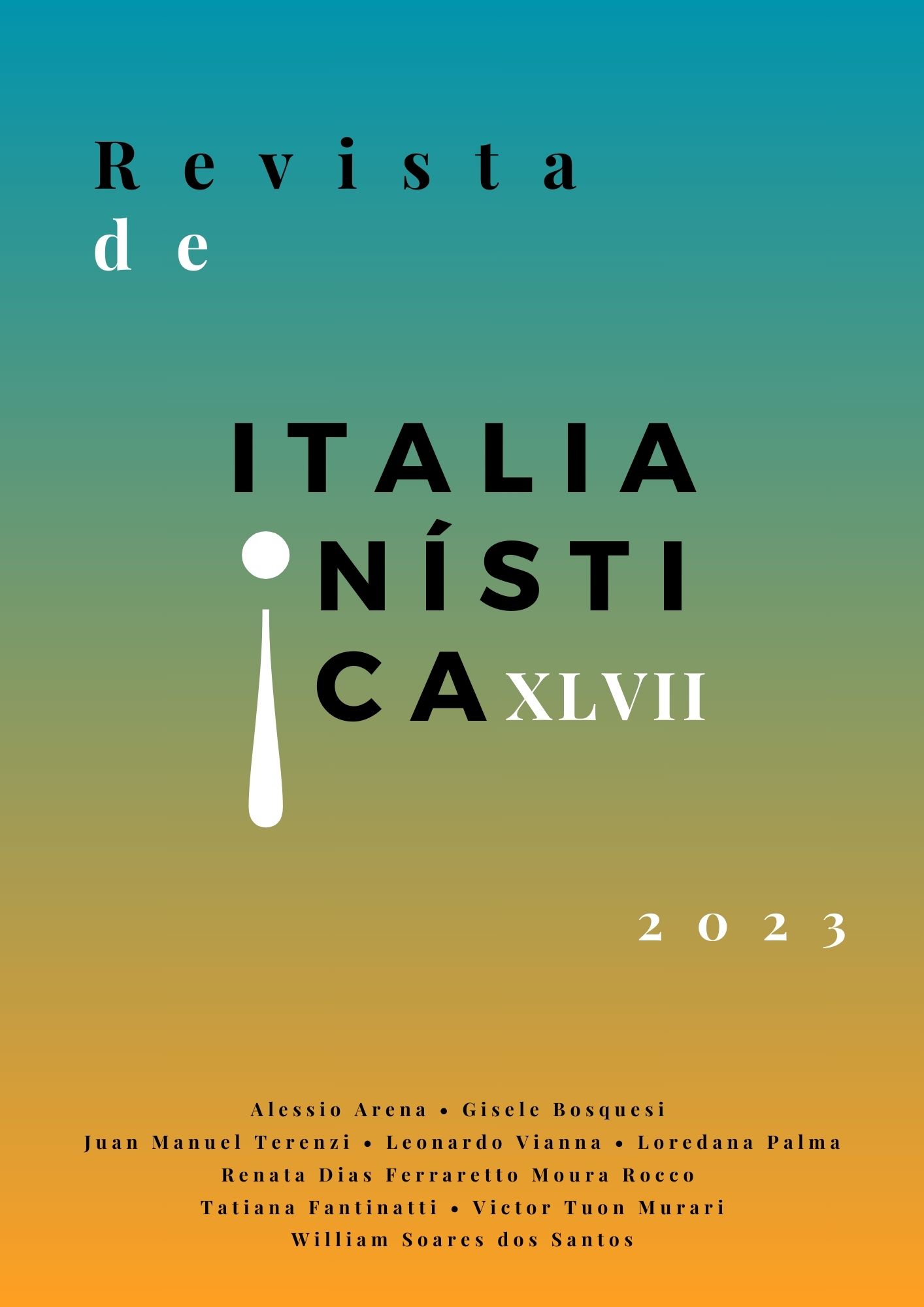Napoli è mille colori. The teeming City: from Serao’s Paese di Cuccagna to de Giovanni’s Narrative
DOI:
https://doi.org/10.11606/issn.2238-8281.i47p64-86Keywords:
Naples, Landscape, People, Serao, De GiovanniAbstract
Among the cities most “traversed” by the literature of the nineteenth and twentieth centuries, an important place is occupied by Naples. Described by its children and by travelers passing through, in novels and reports, immortalized in representations of various kinds – from the views of Pitloo to canvases by Migliaro, from photography to cinematography (from Mario Martone’s Il sindaco del rione Sanità, to the latest Sorrentino in It was the Hand of God, passing through two “foreigners” like Turturro and Ozpetek, directors respectively of Passione and Napoli velata), Naples is described in a thousand different ways, but never in an aseptic way. In the story of the city, in fact, two essential elements are never missing: the gaze of the observer and the human element that is an integral part of the landscape. Evoked even in music (from Marechiare to Napul’è by Pino Daniele), the city remains an ineffable mystery for its own inhabitants and its vision is refracted in a thousand images, from black and white to color, each of which contains a piece of truth. To the ecstatic contemplation, from above, of the Gulf and Vesuvius, are opposed, in the lower part, as much in writing as in visual representations, dark alleys, streets teeming with life, love and pain, hope and resignation, luxury and misery. This will be the path that will lead us, from the nineteenth to the twenty-first century, from the tumultuous city of Matilde Serao’s Paese di Cuccagna to the equally animated city of Maurizio de Giovanni without Naples having lost its ability to amaze and be told in its many different colors.
Downloads
References
DE GIOVANNI, M., I bastardi di Pizzofalcone, Torino, Einaudi, 2013.
DE GIOVANNI, M., La condanna del sangue. La primavera del commissario Ricciardi [2008], Torino, Einaudi, 2012b.
DE GIOVANNI M., Per mano mia. Il Natale del commissario Ricciardi, Torino, Einaudi, 2011.
DE GIOVANNI, M., Il senso del dolore. L’inverno del commissario Ricciardi [2007], Torino, Einaudi, 2012a.
MASTRIANI, F., Il mio cadavere, Napoli, Omnibus, 1852.
SAVIANO, R., Gomorra. Viaggio nell'impero economico e nel sogno di dominio della camorra, Milano, Mondadori, 2006.
SERAO, M., All’erta, Sentinella! Terno secco-Trenta per cento-O Giovannino o la morte. Racconti napoletani, Milano, Baldini & Castoldi, 1904.
SERAO, M., Il paese di Cuccagna. Romanzo napoletano [1889-1891], De Caprio, C. (a cura di), Napoli, Partagées, 2004.
SERAO, M., Il romanzo della fanciulla, Milano, Treves, 1886.
SERAO, M., Il ventre di Napoli, Milano, Treves, 1884.
PUBBLICAZIONI ONLINE:
CATÀ C., "Non ti disunire". Mistero e grandezza della battuta cult di Sorrentino. In: HuffPost Italia. Disponibile a: "Non ti disunire". Mistero e grandezza della battuta cult di Sorrentino - HuffPost Italia (huffingtonpost.it). Access in: 23 apr. 2022.
FILM E MATERIALE ICONOGRAFICO:
Film:
DE SICA, V. Il Giudizio Universale, Francia e Italia, De Laurentiis, 1961, 98’
GARRONE, M. Gomorra, Italia, Fandango, 2008, 137’.
LOY, N. Mi manda Picone, Italia, Medusa, 1983, 120’.
MARTONE, M. Il sindaco del rione Sanità, Italia, Indigo film, 2019, 115’.
MARTONE, M. Qui rido io, Italia e Spagna, Indigo film, 2021, 133’.
OZPETEK, F., Napoli velata, Italia, Warner Bros Italia, 2017, 113’.
RUBINI, S. I fratelli De Filippo, Italia, Rai Cinema, 2021, 139’.
SORRENTINO, P. È stata la mano di Dio, Italia, The Apartment,130’.
SORRENTINO, P. La grande bellezza, Italia e Francia, Indigo film, 2013, 143’.
TURTURRO, J. Passione, Italia e Stati Uniti, Skydancer, 2010, 90’.
Televisione:
ARISTARCO, T. (regista). Mina Settembre (serie televisiva), Italia, Rai Fiction, 2021.
CARLEI, C. – D’ALATRI, A. – VULLO, M. (registi). I bastardi di Pizzofalcone (serie televisiva – 3 stagioni), Italia, Rai Fiction, 2017-2021.
CIPOLLITTI, G. (regista), Ulisse: Il piacere della scoperta. I mille segreti di Napoli, Italia, Rai, 2015.
CIPOLLITTI, G. (regista). Meraviglie – La penisola dei tesori [puntata su Napoli], Italia, Rai, 2022.
CIPOLLITTI, G. (regista). Stanotte a Napoli, Italia, Rai, 2021.
COSTANZO, S. – ROHRWACHER, A. – LUCHETTI, D. L’amica geniale (serie televisiva – 3 stagioni), Italia e Stati Uniti, Fandango e Wildside, 2018-2022.
D’ALATRI, A. – TESCARI, G. (registi). Il commissario Ricciardi (serie televisiva), Italia, Rai Fiction, 2021.
PELLEGRINI, L. (regista). Carosello Carosone (film TV), Italia, Rai Fiction, 2021.
SOLLIMA, S. – COMENCINI, F. – CUPELLINI, C. – GIOVANNESI, C. – D’AMORE, M. (registi). Gomorra (serie televisiva 5 stagioni), Italia, Sky – Cattleya – Fandango, 2014-2021.
Sculture:
SAMMARTINO, G. Cristo velato, 1753, marmo [collocazione: Cappella Sansevero, Napoli].
Dischi:
Campi Flegrei. BENNATO, E., Ricordi, 1973, vinile, 4:19.
Marechiare. DI GIACOMO, S. e TOSTI, F. P., 1886.
Munasterio ’e Santa Chiara. GALDIERI, M. e BARBERIS, A., 1945.
Napul’è. DANIELE, P., EMI, 1977, CD, vinile, 3:47.
Nisida. BENNATO, E., Ricordi, 1982, vinile, 5:15.
’O paese d’’o sole. D’ANNIBALE, V. e BOVIO, L., 1925.
Pusilleco addiruso. MUROLO, E. e GAMBARDELLA, S., Bideri, 1904.
Santa Lucia luntana. MARIO, E. A., 1919.
Torna a Surriento. DE CURTIS, E. e DE CURTIS, G., 1894.
Tu ca nun chiagne. DE CURTIS, E. e BOVIO, L., La Canzonetta, 1915.
Downloads
Published
Issue
Section
License
Copyright (c) 2023 Revista de Italianística

This work is licensed under a Creative Commons Attribution-NonCommercial-NoDerivatives 4.0 International License.
A revista retém os direitos patrimoniais dos artigos e os publica simultâneamente sob uma Licença Creative Commons-Atribuição-Não Comercial-Sem Derivações.



